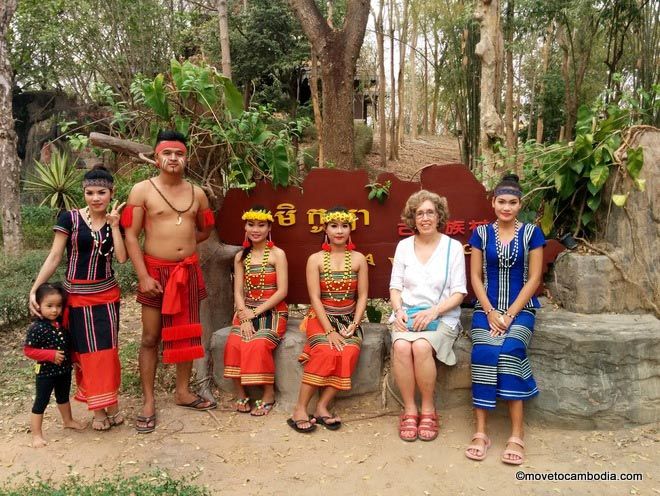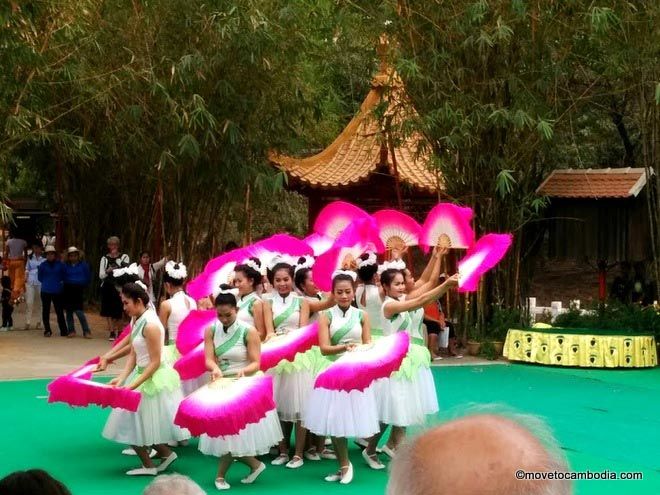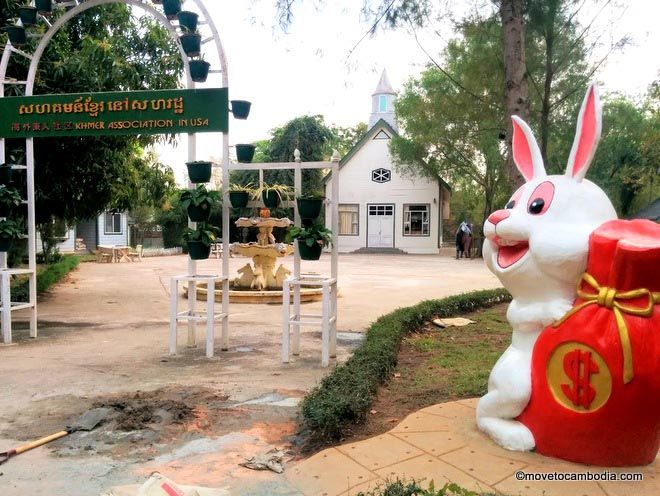In a town dominated by foreign tourism, the Cambodian Cultural Village in Siem Reap offers a uniquely local — and to Western eyes, decidedly odd — take on Cambodian culture and history. Part amateur museum, part theme park, part fun fair, the CCV may disappoint more serious-minded visitors, but it’s an ideal outing for those with young children to entertain or a taste for the quirkier side of the Kingdom.

Just one of many photo ops at the Cambodian Cultural Village in Siem Reap.
The Cambodian Cultural Village aims to sum up the essence of Cambodia within 210,000 square meters (about 52 acres). There are miniature versions of the Royal Palace in Phnom Penh, the Reclining Buddha, and other famous landmarks (“It like you have traveled all over Cambodia in haft day,” boasts the CCV’s vaguely English-language web site) and a series of “villages” dedicated to the Khmer and six of the country’s other ethnicities, including the Cham and the Chinese.
What goes on in most of these “villages” are colorfully costumed dance and acrobatic shows put on by an energetic troupe of Cambodian youths, presenting the purported legends and folkways of the various groups in a style more show-biz than anthropological. There’s some kind of performance going on pretty much all day, from a Khmer wedding to Chinese acrobats. During our visit the shows were applauded by an enthusiastic crowd of Cambodian teens, orange-robed monks, French and Korean tourists, and church groups, including a crew whose yellow vests identified them as “Happy Church Best Cinderella Miracle Center.”

There are eight performances a day — this one is the ‘Happy Chinese Dancing Show.’
A tiny museum by the entrance introduces some of the country’s distinctive fauna in the form of distressingly bedraggled taxidermy. There’s a mysterious array of objects — tools, vases — labeled only in Khmer and Chinese. Murals and crudely rendered life-sized dioramas show Jayavarman VII defeating the Cham and consulting with his architects while slaves drag blocks of stone that will become Angkor Wat.
Across the way, a waxworks presents creepily not-quite-lifelike versions of various historical personages, from ancient Kreung tribespeople to 1960s pop star Sinn Sisamouth. Despite signs prohibiting photographs, CCV staff ignored the visitors happily shooting selfies with King Norodom Suramarit and other dignitaries. A notorious display memorializing the early-1990s United Nations Transitional Authority has been removed, reportedly after protests from the UN. The scene showed a blue-bereted UNTAC soldier embracing a bar girl, its implicit message widely thought to be that this was how AIDS came to Cambodia. But still in place are plenty of bare-breasted Apsara maidens and a “happy family” in a 1950s domestic setting that’s straight out of a David Lynch nightmare.
Elsewhere in the park are an ersatz mountain with waterfall, a restaurant that seems to specialize in foot massages, and playground equipment in all shapes and sizes (a favorite is a giant gold Buddha head whose mouth you can climb into). There’s a “floating village” and a “village” devoted to Cambodian emigres to the United States, a collection of a few empty, vaguely New England buildings flanked by a sculpture of a giant bunny clutching a bag of dollars and another of a headless Superman holding aloft a giant rock. Is this a random aggregation of Western imagery or a pointed critique of U.S. policy?

The Khmer diaspora represented by a giant white bunny carrying a bag of US dollars. Obviously.
Even more mysterious is the Judgment Tunnel Ghost House, a dark maze filled with effigies of people being tortured and a soundtrack of recorded screams. It’s genuinely terrifying thanks to the near total darkness, the complete lack of directional signage, and the park employees in ghost costumes who crawl around the floor grabbing at visitor’s ankles as they flail about trying to find the exit.
This heart-stopping attraction, the day-long menu of shows, the museum, and the waxworks are all included in the admission price, a steep $15 for foreigners (or $5 for Khmers), but free for children under 1.1 meters or 43 inches tall. If money is no object and even a short walk seems too strenuous, additional fees will get you a guide, an electric golf cart, or both. Details can be found on their unintentionally amusing web site.
Anyone expecting a Disney level of polish may well feel that the Cambodian Cultural Village falls far short of being worth the admission price. The place looks dilapidated and many of the souvenir shops and other concessions appeared to be closed on the day we visited. But connoisseurs of the Cambodian surreal will find it money well spent. Don’t put off your visit, however. As Siem Reap becomes more and more genuinely international, it seems likely this homegrown salute to Cambodia will be replaced by something slicker, more corporate, and vastly less entertaining.
Cambodian Cultural Village
National Road 6, Siem Reap
T: 063 963 098
www.cambodianculturalvillage.com
Leave a Reply